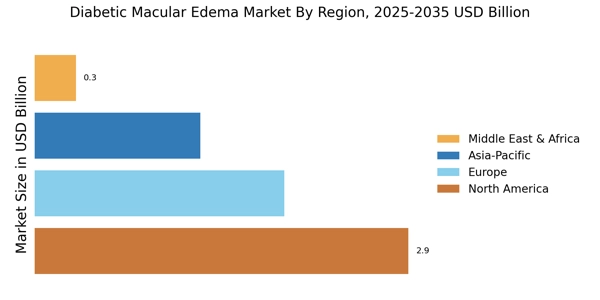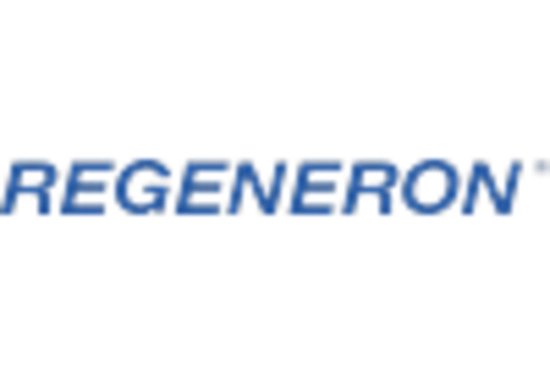The Diabetic Macular Edema Market is characterized by a dynamic competitive landscape, driven by increasing prevalence rates of diabetes and a growing demand for effective treatment options. Key players such as Regeneron Pharmaceuticals (US), Novartis (CH), and Roche (CH) are at the forefront, each adopting distinct strategies to enhance their market presence. Regeneron Pharmaceuticals (US) focuses on innovation, particularly with its Eylea product, which has shown promising results in clinical trials for DME. Meanwhile, Novartis (CH) emphasizes strategic partnerships, collaborating with various healthcare organizations to expand its reach and improve patient access to therapies. Roche (CH) is investing heavily in digital transformation, aiming to leverage data analytics to optimize treatment outcomes and patient engagement. Collectively, these strategies contribute to a competitive environment that is increasingly centered around innovation and patient-centric solutions.
In terms of business tactics, companies are localizing manufacturing and optimizing supply chains to enhance efficiency and reduce costs. The market structure appears moderately fragmented, with several players vying for market share. However, the influence of major companies is substantial, as they set the pace for innovation and establish benchmarks for quality and efficacy in treatment options.
In August 2025, Regeneron Pharmaceuticals (US) announced a significant expansion of its clinical trial program for Eylea, targeting new patient populations and exploring combination therapies. This strategic move is likely to enhance its competitive edge by broadening the therapeutic applications of its flagship product, potentially capturing a larger share of the DME market.
In September 2025, Novartis (CH) launched a new initiative aimed at improving access to DME treatments in underserved regions. This initiative, which includes partnerships with local healthcare providers, underscores the company's commitment to addressing health disparities and could strengthen its market position by fostering goodwill and loyalty among healthcare professionals and patients alike.
In October 2025, Roche (CH) unveiled a new digital platform designed to facilitate remote monitoring of DME patients. This innovative approach not only enhances patient engagement but also allows for real-time data collection, which could lead to improved treatment outcomes. By integrating technology into its service offerings, Roche positions itself as a leader in the digital health space, potentially reshaping the competitive dynamics of the market.
As of October 2025, current trends in the Diabetic Macular Edema Market indicate a shift towards digitalization, sustainability, and the integration of artificial intelligence in treatment protocols. Strategic alliances are increasingly shaping the landscape, as companies recognize the value of collaboration in driving innovation. Looking ahead, competitive differentiation is likely to evolve from traditional price-based competition to a focus on technological advancements, innovative treatment solutions, and reliable supply chains, reflecting a broader industry trend towards value-based care.


















Leave a Comment